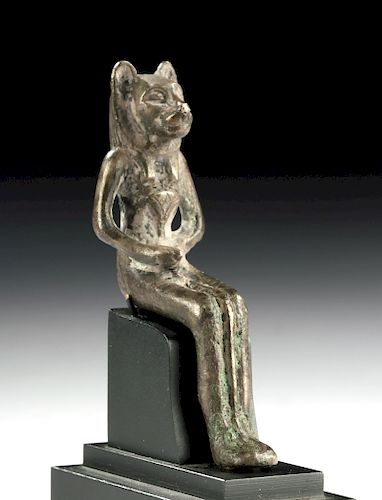Egyptian Silver Statuette of Sekhmet - 36.1 g
Lot 5d
About Seller
Artemis Fine Arts
686 S Taylor Ave, Ste 106
Louisville, CO 80027
United States
Selling antiquities, ancient and ethnographic art online since 1993, Artemis Gallery specializes in Classical Antiquities (Egyptian, Greek, Roman, Near Eastern), Asian, Pre-Columbian, African / Tribal / Oceanographic art. Our extensive inventory includes pottery, stone, metal, wood, glass and textil...Read more
Estimate:
$16,000 - $24,000
Absentee vs Live bid
Two ways to bid:
- Leave a max absentee bid and the platform will bid on your behalf up to your maximum bid during the live auction.
- Bid live during the auction and your bids will be submitted real-time to the auctioneer.
Bid Increments
| Price | Bid Increment |
|---|---|
| $0 | $25 |
| $300 | $50 |
| $1,000 | $100 |
| $2,000 | $250 |
| $5,000 | $500 |
| $10,000 | $1,000 |
| $20,000 | $2,500 |
| $50,000 | $5,000 |
| $100,000 | $10,000 |
| $200,000 | $20,000 |
About Auction
By Artemis Fine Arts
Sep 26, 2019
Set Reminder
2019-09-26 10:00:00
2019-09-26 10:00:00
America/New_York
Bidsquare
Bidsquare : Exceptional Day 1: Antiquities & Asian Art
https://www.bidsquare.com/auctions/artemis-gallery/exceptional-day-1-antiquities-asian-art-4437
Day 1 of an important 2-day auction featuring exceptional, museum-worthy examples of Egyptian, Greek, Etruscan, Roman, Viking, Russian, Near Eastern, as well as Asian Art from China, Japan, Thailand, Vietnam, Burma and India. Artemis Fine Arts info@artemisgallery.com
Day 1 of an important 2-day auction featuring exceptional, museum-worthy examples of Egyptian, Greek, Etruscan, Roman, Viking, Russian, Near Eastern, as well as Asian Art from China, Japan, Thailand, Vietnam, Burma and India. Artemis Fine Arts info@artemisgallery.com
- Lot Description
Ancient Egypt, Late Dynastic to Ptolemaic Periods, ca. 712 to 30 BCE. A powerful 86% silver votive statuette that is a masterpiece of intricacy, depicting the goddess Sekhmet. She has the head of a lion and the body of a human wearing a long, close fitting robe. Her mane hangs straight down her back like a classic Egyptian wig, blurring the line between animal and goddess. She holds a long stemmed lotus bud in her right hand, symbolic of well being in the afterlife. Originally, this ancient statuette would have been attached to a small base, probably inserted into a shrine, as indicated by the pin underneath her feet. Perhaps it was the centerpiece of a shrine inside the house of a high-ranking official; given the inherent value of silver to the ancient Egyptians, the symbolic significance of Sekhmet, and the mastery of the form, this would have belonged to an elite member of ancient Egyptian society. Size: 1.25" L x 0.7" W x 2.1" H (3.2 cm x 1.8 cm x 5.3 cm); 2.6" H (6.6 cm) on included custom stand; silver is 86% pure; total weight: 36.1 grams
Sekhmet's name means "the powerful one" and she was seen as a strong protector of the pharaohs in both life and death who was also a warrior goddess who would lead them in warfare. Thutmose III, the pharaoh known as the Napoleon of Egypt, referred to her as "Mut" meaning both "mother" and "death". The lioness, her embodied form, was the fiercest hunter known to the Egyptians. She had a violent temper, as befitting a goddess linked to the sun in a desert civilization, and is often depicted dressed in red, the color of blood. In the legend of Ra and Hathor, furious Sekhmet would have destroyed humanity had Ra not gotten her drunk.
Temple inscriptions indicate that Egyptians valued silver more highly than gold, in part because it was so scarce. Indeed, it is not fully understood where Egyptians imported silver from, though it is theorized to be the Eastern Mediterranean. They associated silver with the moon, the purity required for rituals, and the bones of the gods (who had golden flesh). It seems to have been reserved especially for deities related to the sun, perhaps because of the sun/moon dichotomy.
Provenance: private Los Angeles, California, USA collection; ex-Safani Gallery, New York, USA, acquired in 2003
All items legal to buy/sell under U.S. Statute covering cultural patrimony Code 2600, CHAPTER 14, and are guaranteed to be as described or your money back.
A Certificate of Authenticity will accompany all winning bids.
We ship worldwide and handle all shipping in-house for your convenience.
#149942Rich patina on surface. Excellent preservation of form with light deposits in lower profile areas.Condition
- Shipping Info
-
All shipping is handled in-house for your convenience. Your invoice from Artemis Gallery will include shipping calculation instructions. If in doubt, please inquire BEFORE bidding for estimated shipping costs for individual items.
-
- Buyer's Premium



 EUR
EUR CAD
CAD AUD
AUD GBP
GBP MXN
MXN HKD
HKD CNY
CNY MYR
MYR SEK
SEK SGD
SGD CHF
CHF THB
THB














